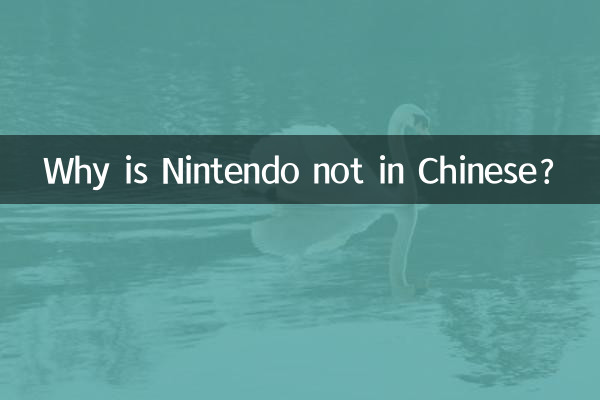Why doesn’t Nintendo have Chinese? Analyzing the Chinese market strategy of gaming giants
In recent years, Nintendo has become a world-renowned game manufacturer, and its products such as Switch, The Legend of Zelda, and Pokémon have become popular all over the world. However, many Chinese players have always had a question: Why do some of Nintendo's games and systems not support Chinese? This article will explore the reasons behind this phenomenon through structured data and analysis.
1. Hot topics on the Internet in the past 10 days and discussions related to Nintendo

| hot topics | Discussion popularity | Main point |
|---|---|---|
| Nintendo Switch 2 Rumors | high | Players expect new models to support Chinese systems |
| "The Legend of Zelda" new work | extremely high | Chinese players complained that the previous game had no Chinese language |
| Pokémon new product press conference | high | Chinese players look forward to official Chinese support |
| Independent game Chinese support | middle | Comparing the lack of Chinese in Nintendo’s first-party games |
2. Analysis of current status of Nintendo’s Chinese support
According to player community statistics, Nintendo’s Chinese support is as follows:
| Game/System | Chinese support | Release time |
|---|---|---|
| Switch system | Chinese added in 2019 | First release in 2017 without Chinese language |
| "The Legend of Zelda: Breath of the Wild" | Chinese will be added in subsequent updates | First release in 2017 without Chinese language |
| "Pokémon" series | Support Chinese since 2016 | There was no official Chinese language before 2016 |
| "Fire Emblem" series | Some works are not in Chinese | Gradually support after 2019 |
3. Why didn’t Nintendo provide Chinese support in the early days?
1.Market strategy considerations: In the early days, Nintendo mainly targeted the Japanese, European and American markets, and the Chinese market had a lower priority.
2.cost control: Localization requires a lot of investment in manpower and material resources, and Nintendo may think that the return rate is insufficient.
3.piracy problem: There was a serious piracy problem in the Chinese region, which affected genuine sales.
4.Partner restrictions: Some games are developed by third parties, and Chinese support depends on the developer.
4. Changes in recent years and future prospects
With the rapid growth of the Chinese game market, Nintendo's attitude has changed significantly:
| time | event | significance |
|---|---|---|
| 2016 | "Pokémon Sun and Moon" is officially released in Chinese for the first time | Opening up culture in first-party games |
| 2019 | Switch system Chinese support | System-level Chinese culture |
| 2020 | "Assemble!" "Animal Crossing: New Horizons" synchronized in Chinese | Important works synchronize with Chinese culture |
5. Differences in views among the player community
1.Supporters: I think Nintendo has made improvements and should be given time.
2.critic: Point out that Sony and Microsoft have more comprehensive Chinese support, while Nintendo lags behind.
3.neutral party: It is recommended to distinguish the Chinese support status of first-party and third-party games.
6. Summary and suggestions
Nintendo's hesitation on Chinese support has historical reasons, but the situation is improving as the importance of the Chinese game market increases. For players, they can express their demands in the following ways:
1. Purchase the official Chinese version of the game and prove its market value with sales volume
2. Reasonably express Chinese cultural needs through official channels
3. Pay attention to Nintendo’s progress in Chinese culture and support Chinese-cultured works.
As the Chinese game market continues to grow, Nintendo is likely to further expand the scope of Chinese support, and we may see more Nintendo masterpieces synchronized with Chinese culture in the future.

check the details

check the details